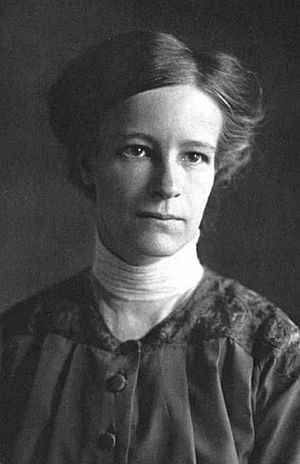Elisabeth Vreede facts for kids
Elisabeth Vreede (born July 16, 1879, in The Hague – died August 31, 1943, in Ascona) was a Dutch mathematician and astronomer. She was also a follower of Anthroposophy, a special way of understanding the world.
Early Life and Learning
| Part of a series on |
| Anthroposophy |
|---|
| General |
|
| Anthroposophically inspired work |
|
| Philosophy |
|
Elisabeth Vreede was born in The Hague, Netherlands, in 1879. She was the second child of her parents. Her father was a lawyer, and her mother spent her time helping others. Elisabeth was a thoughtful person. She later played a big part in the Anthroposophical movement in the Netherlands.
Elisabeth Vreede learned about Theosophy at home when she was growing up. She became interested in the starry sky very early. She read books by the astronomer Camille Flammarion and learned French at the same time. She started school when she was seven. After finishing primary and higher schools, she studied privately for two years. This helped her get ready for university.
At the University of Leyden, she studied mathematics, astronomy, and philosophy. She was also very active in student life. She started a boat club and was on the student union council.
Her first meeting with Rudolf Steiner happened in London in 1903. This was at a Theosophical Congress. Her parents were Theosophists, and she was also a member of the Theosophical Society. Rudolf Steiner made a strong impression on her at this meeting. A year later, she heard Steiner give a lecture in Amsterdam in 1904.
Teaching and Anthroposophy Work
After getting her diploma in 1906, Elisabeth taught mathematics at a girls' school until 1910. From 1910, she lived in Berlin. There, she worked on her advanced degree and sometimes helped Rudolf Steiner as a secretary. In April 1914, she moved to Dornach. She went there to help build the first Goetheanum. She often helped by carving wood for the building.
During World War I, in 1916 and 1917, Elisabeth Vreede left Dornach for a time. She worked in Berlin with Elisabeth Rotten. They helped care for prisoners of war.
After the war, Rudolf Steiner developed his idea of the threefold social order. This was about how society could be organized better. Vreede was very interested in this idea. She was the first person to bring this concept to England. Around 1918, she started building a library and archive at the Goetheanum. She used her own money to buy expensive copies of lectures. Friends sometimes helped her efforts to build this important archive.
In 1920, Vreede moved to Arlesheim. She had built her own small house there. Rudolf Steiner himself had given the design for this house in 1919. In Arlesheim, Ita Wegman started the first Anthroposophical medical clinic in 1921.
In December 1923, Vreede was chosen to lead the Mathematical-Astronomical Section. This was part of the School of Spiritual Science at the Goetheanum. She was also on the board of directors of the General Anthroposophical Society from December 1923 to 1935. In 1924, she attended Rudolf Steiner's Agriculture Course in Koberwitz. This course laid the groundwork for biodynamic agriculture, a special way of farming.
Between September 1927 and August 1930, she wrote a monthly letter. This letter was for people who subscribed to it. It discussed both modern astronomy and classical astrology. It looked at these topics through the lens of spiritual science. The letters explained basic astronomy. They also talked about astrology in the modern world. Topics included nutation, precession of the equinoxes, comets, solar eclipses, and lunar eclipses. She also wrote about the meaning of Christian holidays like Easter and Whitsun. These letters were published in English in 2007. The book was called Astronomy and Spiritual Science.
In July 1930, she gave two lectures in Stuttgart. These lectures were about the Bodhisattva question in the history of the Anthroposophical Society. They were published in English in 1993.
Later Life
In 1935, there was a disagreement within the Anthroposophical Society. As a result, Vreede was removed from the board of directors. Her section was then given to other people. This happened after many discussions within the Society. When she was removed, along with Ita Wegman, Vreede lost access to the observatory and archives. She had helped put these together herself.
The last years of her life became more solitary. World War II cut her off from her friends abroad. The death of Ita Wegman in March 1943 was a great shock to her. She spoke at Ita Wegman's memorial service at the clinic. It was the first time she faced her former colleagues from the board.
On the anniversary of Rudolf Steiner's death (March 30), she spoke to friends and co-workers. This was at Ita Wegman's clinic in Arlesheim. They wanted to remember Rudolf Steiner. They also wanted to remember other important Anthroposophists who were not as well known anymore. She spoke fondly of Edith Maryon and Alice Sauerwein. She also talked about Count Keyserlingk and Louis Werbeck. Finally, she shared stories about Caroline von Heydebrand and Eugen Kolisko.
In early May, she spoke again. This was for the 400th anniversary of the death of Nicolaus Copernicus. During this lecture, people noticed she had to try very hard to stand upright. A few days later, on May 6, she had to stay in bed. She had never been ill before. She was cared for at home by Frl. Schunemann.
She had a serious illness called septicaemia. She had periods of high fever and shivering. She could not eat, and other problems developed, like heart weakness and blood poisoning. Doctors Kaelin and Martin helped with her treatment. The infection spread quickly. After a small improvement, she went to Ascona. This was where the Casa Andrea Cristoforo clinic, founded by Ita Wegman, was located. She died there on August 31, 1943.


